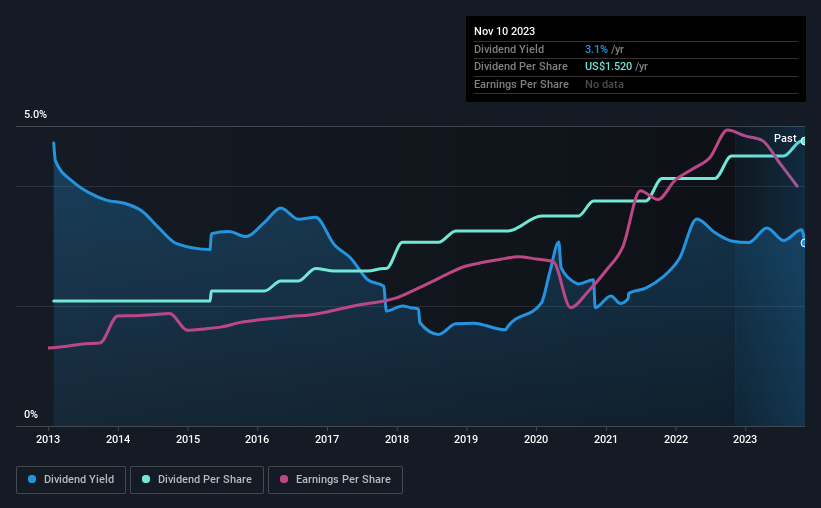Should You Buy Fidelity D & D Bancorp, Inc. (NASDAQ:FDBC) For Its Upcoming Dividend?
It looks like Fidelity D & D Bancorp, Inc. (NASDAQ:FDBC) is about to go ex-dividend in the next 4 days. The ex-dividend date is usually set to be one business day before the record date which is the cut-off date on which you must be present on the company's books as a shareholder in order to receive the dividend. The ex-dividend date is important as the process of settlement involves two full business days. So if you miss that date, you would not show up on the company's books on the record date. Thus, you can purchase Fidelity D & D Bancorp's shares before the 16th of November in order to receive the dividend, which the company will pay on the 8th of December.
The company's next dividend payment will be US$0.38 per share. Last year, in total, the company distributed US$1.52 to shareholders. Looking at the last 12 months of distributions, Fidelity D & D Bancorp has a trailing yield of approximately 3.1% on its current stock price of $49.82. If you buy this business for its dividend, you should have an idea of whether Fidelity D & D Bancorp's dividend is reliable and sustainable. So we need to check whether the dividend payments are covered, and if earnings are growing.
View our latest analysis for Fidelity D & D Bancorp
If a company pays out more in dividends than it earned, then the dividend might become unsustainable - hardly an ideal situation. That's why it's good to see Fidelity D & D Bancorp paying out a modest 33% of its earnings.
When a company paid out less in dividends than it earned in profit, this generally suggests its dividend is affordable. The lower the % of its profit that it pays out, the greater the margin of safety for the dividend if the business enters a downturn.
Click here to see how much of its profit Fidelity D & D Bancorp paid out over the last 12 months.
Have Earnings And Dividends Been Growing?
Companies with consistently growing earnings per share generally make the best dividend stocks, as they usually find it easier to grow dividends per share. If earnings fall far enough, the company could be forced to cut its dividend. For this reason, we're glad to see Fidelity D & D Bancorp's earnings per share have risen 13% per annum over the last five years.
Many investors will assess a company's dividend performance by evaluating how much the dividend payments have changed over time. Fidelity D & D Bancorp has delivered 8.6% dividend growth per year on average over the past 10 years. It's encouraging to see the company lifting dividends while earnings are growing, suggesting at least some corporate interest in rewarding shareholders.
The Bottom Line
Is Fidelity D & D Bancorp an attractive dividend stock, or better left on the shelf? When companies are growing rapidly and retaining a majority of the profits within the business, it's usually a sign that reinvesting earnings creates more value than paying dividends to shareholders. Perhaps even more importantly - this can sometimes signal management is focused on the long term future of the business. We think this is a pretty attractive combination, and would be interested in investigating Fidelity D & D Bancorp more closely.
Want to learn more about Fidelity D & D Bancorp? Here's a visualisation of its historical rate of revenue and earnings growth.
If you're in the market for strong dividend payers, we recommend checking our selection of top dividend stocks.
Have feedback on this article? Concerned about the content? Get in touch with us directly. Alternatively, email editorial-team (at) simplywallst.com.
This article by Simply Wall St is general in nature. We provide commentary based on historical data and analyst forecasts only using an unbiased methodology and our articles are not intended to be financial advice. It does not constitute a recommendation to buy or sell any stock, and does not take account of your objectives, or your financial situation. We aim to bring you long-term focused analysis driven by fundamental data. Note that our analysis may not factor in the latest price-sensitive company announcements or qualitative material. Simply Wall St has no position in any stocks mentioned.

